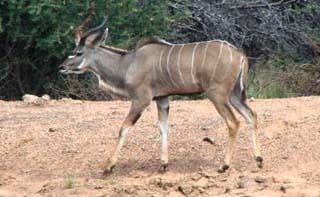Greater Kudu

This is due to a declining habitat, deforestation and hunting. The Greater Kudu lives in thick bushveld, rocky hillsides, and dry riverbeds. They also need a constant supply of water. The Greater Kudu feeds on leaves, grass, shoots, tubers, roots and fruit.
Characteristics
They have a narrow body with long legs and a brown or bluish-grey to reddish-brown coat. Their head is darker than the body, there is a small chevron between the eyes and 4-12 vertical white stripes can be found on the torso. Males are much larger than females, they have a long mane along the throat and large twisted horns. These horns start to grow between 6-12 months. Males weigh between 190-270kg, while females weigh between 120-210kg.
Behaviour
Females live in herds of about 6-20 individuals, together with their calves. The males are usually solitary, but are known to sometimes form a bachelor herd of about 4-8 young males. Males fight by interlocking horns. This can sometimes result in the horns getting stuck, thus making it impossible for the kudu to find or ingest food or water. This, in turn, causes the kudus to die of dehydration. Females fight the males by biting them, due to their lack of horns.
The Greater Kudu matures sexually between 1-3 years of age. Mating occurs at the end of rain season, and gestation is 240 days. Usually only one calf is born at a time, but two are sometimes seen as well. Males become self-sufficient at 6 months, and females at 1-2 years old.
